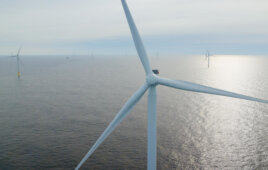by Ed Weston
Despite the push from Washington and state capitals for ‘green jobs,’ the wind industry has found them harder to create than expected. Latest estimates of domestic content of US turbines are estimated at less than 50%. With the help of organizations like the Great Lakes WIND Network, however, pieces are being put in place to overcome the issues and accelerate the growth of wind turbine component manufacturing jobs in America.
So why is it so difficult for American manufacturers to produce the castings, fabrications, and heavy equipment needed for large-scale wind operations? The short answer is that several important linkages are too new to effectively bond the forces that need to combine for manufacturing growth. There are three forces at work here:
–Original equipment manufacturers (OEMs) from Europe and Asia are flooding US shores, looking for good places to locate and bringing with them proven wind turbine designs and knowledge of what these units should cost to build. Most OEMs know what they want from a supplier and how much they should have to pay. What they don’t always know here in America is where to find them.
–Potential component suppliers, on the other hand, hear the call for diversification into wind but struggle with market entry. It’s difficult to get the details on exactly what needs to be made, what the industry expects of suppliers, and where to get this information in the first place.
–States and other economic development groups struggle, too. It’s their job to encourage the growth of local firms with loans and other assistance. Their challenge is finding manufacturers capable of expanding into wind and getting them on track to do it. New business recruitment is their other responsibility, and as part of the due diligence for plant siting projects, wind turbine companies inevitably ask them for details of the regional supply chain. Good answers can be hard to produce.
Ideally, these forces form a system that provides the right information to drive the right investments by the right companies in the right places. States provide initial funding, jobs are created, and all is well. But of course, that’s not the case today. Actually, we first saw this problem back in 2006, and it’s why WIRE-Net formed the Great Lakes WIND Network, a non-profit supply chain advisory group and that has grown to some 1300 manufacturers and suppliers with a sole mission to increase the domestic content of North America’s wind turbines.
Our answer to this problem of ‘system disconnects’ was to strengthen the needed linkages between supplier firms, OEMS and economic development agencies. To start, Great Lakes WIND Network pooled its deep knowledge of OEM requirements, practices, and specifications. The result was customized half-day programs that are really data dumps for manufacturers wanting accurate and specific information to make an initial assessment of their fit with the utility scale wind industry. These Supply Chain Workshops are typically sponsored by states and serve as outreach events to build regional wind supply chain. OEMs benefit, too, from the straight talk that attracts the companies that can help them and repels the ones that probably can’t.
To combat the where-do-I-find-the-companies blues, Great Lakes WIND Network (GLWN) created an interactive website that locates its entire network of manufacturers and suppliers on an interactive GIS map. Manufacturers can be searched by industry sector, by geography, or by whether they’ve become active in component production. Results provide hot-links to company websites to facilitate fast connections. Using this website, businesses can seek new customers, partners, and suppliers. As a next step to engaging in the industry, GLWN encourages manufacturers to ‘get listed’ on its website so that they also can be found.
For those wanting further assistance, GLWN offers both telephone support and on-site assistance in the form of a WIND Capabilities Profile. This usually takes a half day and provides manufacturers a jump start in defining their components and industry tier ‘fit,’ as well as summary information on how an OEM would view their quality system and competitiveness.
Great Lakes WIND Network records and stores information from companies that join online, as well as those that request visits, and this data comes in handy when OEMs turn to GLWN for matchmaking help in building or expanding their supply chains. This happens quite often, and since there’s no commission involved, it’s an opportunity for GLWN to showcase the best manufacturers for the applications—and hopefully contribute to new business for domestic manufacturers.
Companies interested in learning more about the Great Lakes WIND Network and its industry-building programs can go to www.glwn.org or call 216-588-1440.
Read more information on upcoming wind power Supply Chain Workshops from the Great Lakes Wind Network.
Filed Under: Projects




